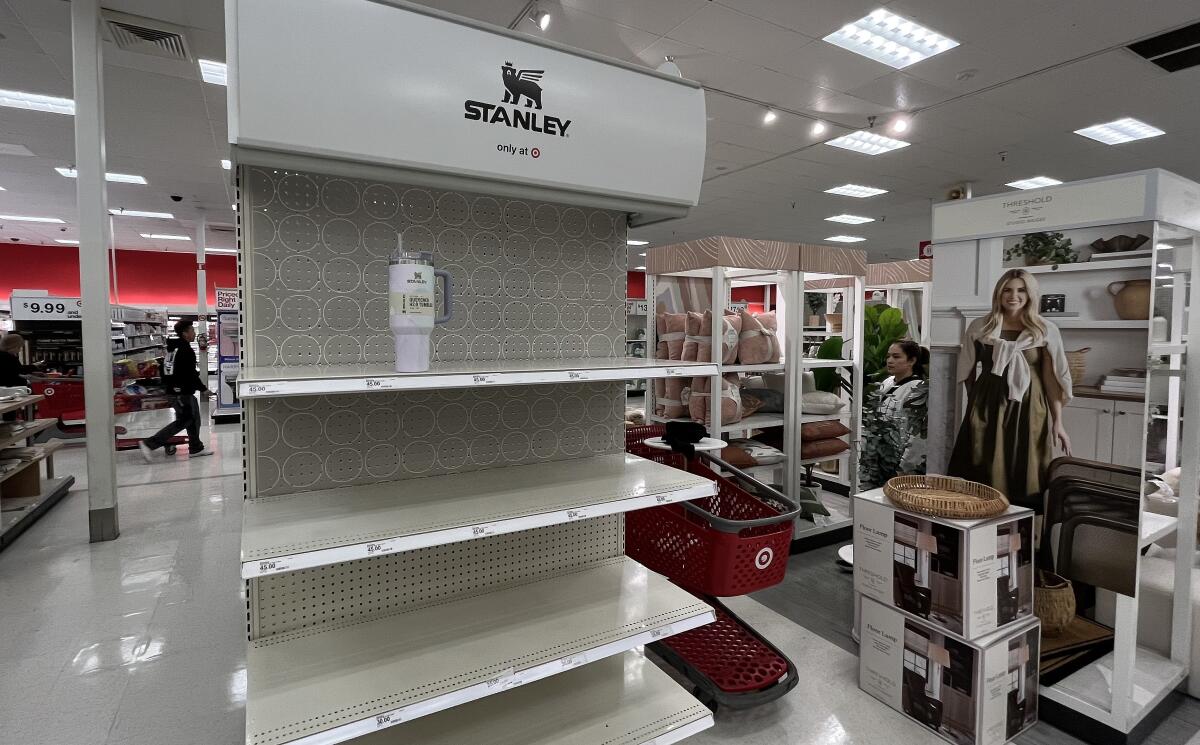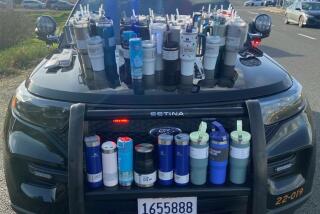The Stanley cup craze is real. What’s causing the merchandise mania

- Share via
The craze has prompted long lines outside of Target stores in the dead of night. Ugly fights have broken out. Shouting matches have erupted. All this hubbub over Stanley cups.
No, not the Stanley Cup awarded to the National Hockey League champion. We are talking about the insulated steel tumblers sold in various colors at Target and Starbucks.
On a recent Friday afternoon, Target shelves in L.A. County were barren, devoid of cups. Surprisingly, there haven’t been reports of people resorting to violence to secure the coveted item, but at least one online video shows a man trying to make a quick getaway from a Target store with a tumbler under his arm, only to be tackled by what appear to be furious shoppers.
It’s not clear how the frenzy started, but it seems to follow the pattern of merchandise mania like the plastic Disney popcorn bucket in the shape of a dragon in 2022, the PlayStation 5 in 2020 and the Popeyes chicken sandwich in 2019.
Collectors and sellers of the tumblers suggest that the craze has been fueled by the manufacturer’s marketing strategy, the collaboration with popular companies like Starbucks, the designer colors and a sense that ownership conveys status and exclusivity.
Influencers on TikTok and other platforms have contributed to the mania by posting catchy videos of the tumblers.
GameStop’s rocketing price defined the insane stock market of 2021. Now it’s plummeting.
But what likely sparked the latest viral popularity was the November TikTok video of a woman’s car that caught fire; her Stanley cup not only survived but kept her beverage cold. The video has had nearly 94 million views. In response, the Stanley company offered to replace not only the cup but her car.
Stanley insulated cups are not new, having been invented by William Stanley Jr. in 1913. But with a dedicated fan base on TikTok, various styles and prices ranging from $20 for a 14-ounce cup to $60 for a 64-ounce version, anything Stanley is hard to come by.
Spokespersons for Target and Stanley could not be reached for comment on the craze.
The most sought-after Stanley cups are the Winter Pink Starbucks collaboration, which have a slight shine in the proper lighting. The cups are fetching upward of $400 on the resell market, according to EBay auctions.
Also popular are Cosmic Pink or Target Red, featured in Target’s “Galentine” collection released Dec. 31, which swiftly sold out online and in stores. On EBay, they are selling for nearly $100.
One anonymous employee in a Hawthorne Target noted that the store received a shipment of the pink tumblers on Thursday and sold out within two minutes.
A recent viral TikTok shows a crowd rushing to secure a pair, prompting staff to issue warnings about the per-person limit. The video has garnered 20 million views, and the hashtag #StanleyTumbler has accumulated more than 1 billion impressions.
Inglewood resident Ubaldo Rene Rodas was introduced to the Stanley trend by his younger sisters, who sent him TikTok videos of people discussing the cups, showing them off and even engaging in fights during sales drops. He attributes the craze partly to the limited availability, which makes the cups something of a collectible.
Rodas quickly became a reseller, taking advantage of the surging demand.
Why is the internet obsessed with McDonald’s furry purple mascot Grimace? Here’s how a birthday promotion became a social media sensation.
He listed both versions of the limited-edition, pink Galentine cups at $100 each on the Facebook Marketplace, marked up from the original price of $45. He recently sold 10 Cosmic Pink Stanleys to a buyer who wanted them for a gender-reveal party.
Through the Facebook Marketplace group, he recently learned that more cups would go on sale at 1 a.m. on Target’s website.
“So I bought 20 of the Cosmic Pink and 20 of the Target Red, the max you could order, just to try and sell,” he said.
Rodas is not a fan of camping out for hyped items due to the frustration and anger that can arise.
“My sisters had asked me to camp out for the Starbucks Winter Pink Stanley, but I said no since I didn’t want to put them in harm’s way,” he said. “If they restock, I might grab more of the pink color, since they are doing the best. But I’ll go on to the next hyped color once Valentine’s Day passes.”
After a recent collaboration between Stanley and country music star Lainey Wilson sold well, Danielle Williams, a reseller in Bellflower, hopped on the trend and started paying closer attention to the market. She has priced the cups at $90 to $110. She said they project a sense of status, like an exclusive club.
Williams secured the cups on Target’s website, avoiding the overnight lines outside. She said it seemed as though the people camping out were “working harder, not smarter.”
A new UC Berkeley course, “Artistry & Entrepreneurship: Taylor’s Version,” is the latest in a wave of higher education curriculums that highlight Taylor Swift’s ascent to global phenomenon.
Since joining the craze, she has sold nearly 50 cups and has no plans to stop.
“I just hope the hype train lasts on these Stanleys, and they don’t fizzle out like other trendy items,” Williams said.
Partly due to its TikTok popularity, Stanley has reported a $676 million increase in revenue over the past four years, according to CNBC.
The craze was noted by the Advertising Specialty Institute, a researcher in promotional products, which declared the Stanley Quencher the most coveted product of 2023. The institute noted that the 40-ounce Quencher H2.0 FlowState tumbler quickly rose to prominence as the epitome of drinkware trends, gaining attention as a viral TikTok sensation.
“The Stanley Quencher is a slam-dunk choice, as well as the exclamation point to drinkware’s incredible run this past decade,” said ASI Editor in Chief C.J. Mittica.
More to Read
Sign up for Essential California
The most important California stories and recommendations in your inbox every morning.
You may occasionally receive promotional content from the Los Angeles Times.

















